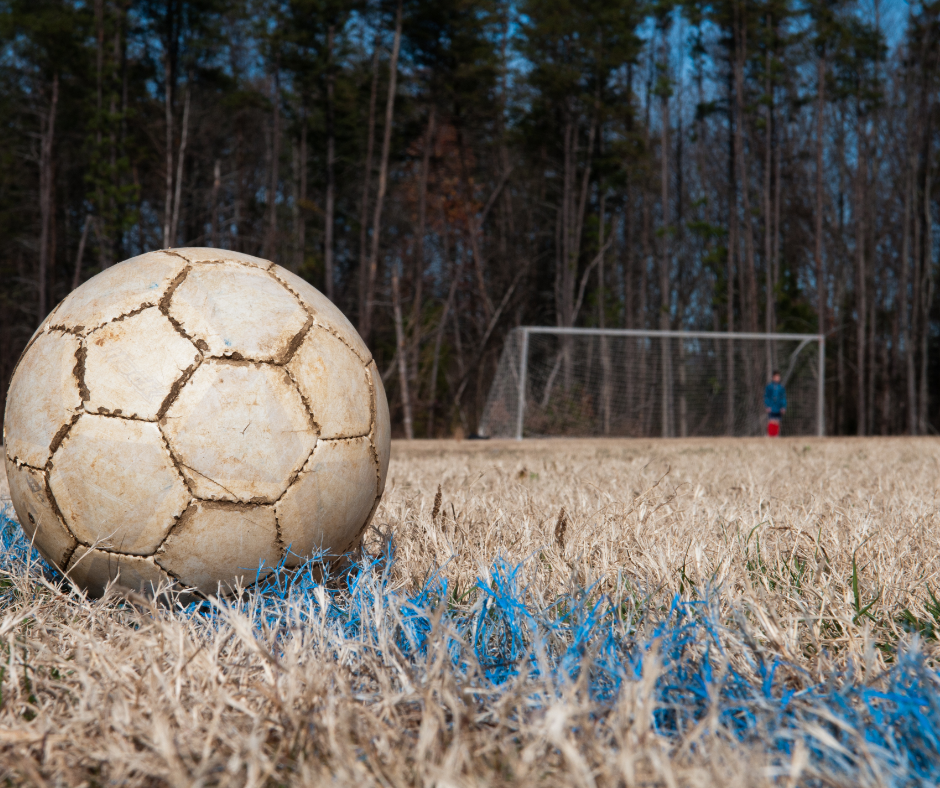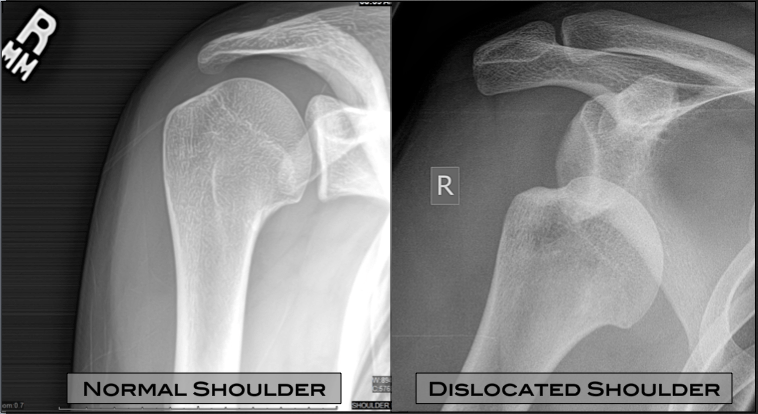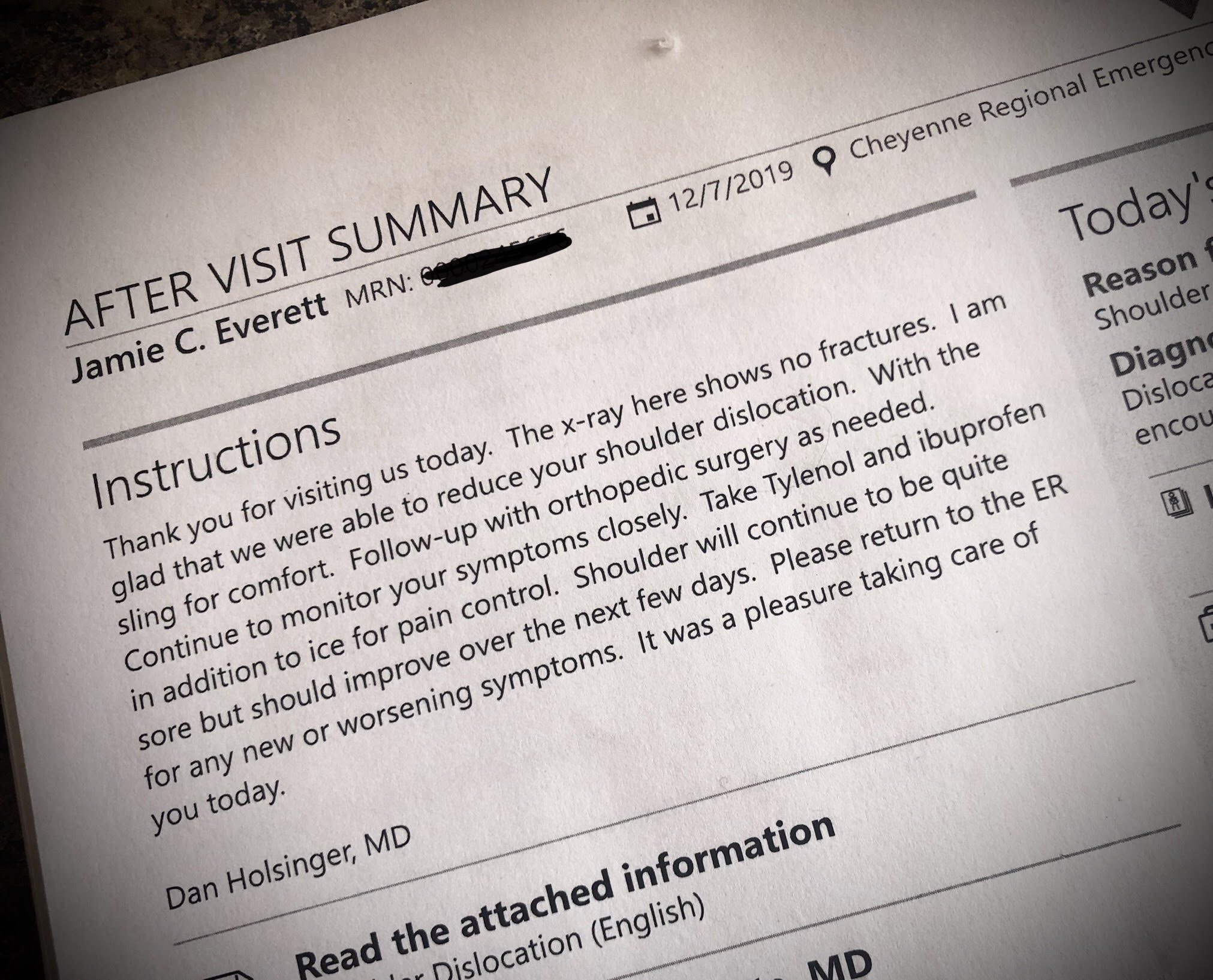The day I went to the Emergency Department in 2019.
I have dislocated my right shoulder on 2 other occasions and on Saturday the 7th of 2019, I dislocated it for the third time.
The 16-year-old me.
My first time was when I was 16. My high school soccer coach had moved me up to center forward as we were in the last 10 minutes of play with the score tied. I was a sweeper, not a center forward. I was used to being the last defender before the opposing team could get to our goalie, but now I was dribbling towards their goal. No one in front of me but their goalie. I kicked up my dribble into overdrive and then…..WHOOSH! I was on my back.

The left defender had come out of nowhere and tackled me from behind. The ref was running from the left of me blowing his whistle, I thought “Great a penalty kick!”
I looked to the right of me to the very top of the stadium bleachers where I caught the eye of my dad. He was nearly a mile away (he had been banned to the top of the stadium by my mother, myself, and maybe the rest of the team). As he was getting closer and closer, I next saw the face of the opposing team’s athletic trainer standing above me right beside the ref and her exact words were “oh God”.
Whoah, what happened??
Then the pain hit. I reached over to my right shoulder as the tears gushed out, I’m pretty sure I mentioned some keywords at the same time. After that began my first experience with physical therapy.
My second time was less eventful but none the less traumatic. To keep a long story short, I fell down the stairs at the age of 30. Sprained ankle and a right dislocated shoulder. Tractioned my own shoulder and drove myself to the orthopedic who was down the hall from the clinic I worked at. I thought I could do my own PT. End of that story
Fast forward to this last weekend. I’m not sure what happened, but I was working in the clinic and fell hard. The minute I hit; I already knew what happened. I lay there trying to move my arm, nope not going to happen. Every little movement was painful, excruciatingly painful. Yep, the tears gushed out again and the memory of my 16-year-old self reappeared.

Image via Dr. Matt Driscoll https://www.mattdriscollmd.com/shoulder-dislocation-matthew-driscoll-sports-medicine.html
Despair hits, fast and hard!
The feeling of despair overcame me. I wasn’t supposed to be injured, I was supposed to help those injured or at least get people resilient enough to not be injured. At 44 years old I kept thinking “get up, pop it back in, and get moving again”, I’m not the 16-year-old scared kid anymore. Still not happening. This was definitely the worst dislocation I’ve had.
I have worked on my shoulder strength, a lot! After my first dislocation, I was in the PT clinic until I could demonstrate a significant amount of strength. I wore my immobilizer faithfully, even after falling upstairs in high school. I was carrying my books in the left arm and immobilizer securing my right arm, with no arm to catch myself after catching my toe on the edge of the step. Splat! Face first.
I hated Therabands but I hated sitting on the bench more!

I worked those TheraBand’s until they broke, I hated Therabands. I liked the weights more. But I had to get better and I couldn’t rush the healing, I didn’t want surgery. Alongside my injury, my two best friends also sustained injuries including an ACL and a meniscus injury. We became known as the “Cougar Crip Crew” as we sat on the bench every game in our junior year. That sucked.
Then into my adulthood as a physical therapist myself, I worked my upper body with weights or pushing body weight. But I still couldn’t confidently overhand serve a volleyball. I was increasingly aware of particular exercises that were overhead. Exercises like Bear walks and burpees made me feel how weak my shoulder was. But I knew that my shoulder wouldn’t just “go out”, what I was feeling was a lack of strength supporting the joint and I needed to keep on track. “Just keep strengthening!” I knew it wasn’t going to pop out again, maybe just feel loose, it would take a great amount of force to dislocate my shoulder again.
“My (insert joint ) keeps going out”
I think this also gave me an idea of how patients feel when they tell me their “hip goes out” or their “back goes out”, it’s a good description. I get it! But sometimes convincing patients that strengthening is the best option isn’t always the easiest. But again, I get it. Fast forward back to the most recent dislocation.
After much convincing, my husband got me to stop trying to relocate my shoulder as well as refusing to go to the ED, and off we went. (*Side note: That truly is a simplified version of what happened during the 45 minutes. There was defiantly a lot of cursing, my husband telling me to not be so dramatic before he knew what was going on, me trying to shout out instructions how to relocate my shoulder to him, multiple attempts to get off the ground, my husband threatening to call an ambulance and then calling my step-son, also a PT, to help. Interestingly, I think there was some pent up frustration that escaped which was coming out in a variety of not-so-nice words towards my husband. Apologies accepted by my husband.)
So I finally make it to the ED with my shoulder dislocation, now what?
The ED physician and team were amazing! “It’s dislocated”, we agreed. First try to relocate, unsuccessful. The second try, I actually thought it was in after he slowly released his grip on my arm. I think the actual words in my head were….no no no NO NO NONONO NO! In that exact ascending tune. I am not sure that that came out of my mouth the same.
Afterward, my husband said I looked at the ED physician like I was in love when I paused from the “no-no-no” and asked, “did you get it in?” followed by my depressing “dang it!” when the doctor said no.
All is calm…
The calmness yet concerning facial expressions from the staff and doctor made me feel at ease. I was going to be helped, I felt like I was at the right place, I felt like they cared for my well-being.
So, onto the last attempt. One person on my left holding the sheet around my chest to keep me from leaning right, the other person behind on my right shoulder depressing my scapula and massaging my deltoid and rotator cuff, and the physician applying traction, rotating, adducting, avoiding my left hand grabbing his elbow, squatting, breaking a sweat, also avoiding my grunts and yells in his ear. And finally, my shoulder was back as a single unit.
No more pain !??!
I left the ED with a pain rating of 0/10 unless I moved my shoulder. Radiographs performed show no signs of fracture. Thumbs up from Dr. Holsinger, the ED physician, who said “you are good to go”, with a reassurance that I would be in some degree of pain and try to take it easy for a little while, maybe not go to CrossFit this weekend. And maybe a follow-up with an orthopedic to see why it keeps dislocating. My thought of course was I should just avoid falling onto my arm.

I am thankful for Dr. Holsinger. He didn’t give me a dreadful prognosis of shoulder dislocations and warned me that I was going to be sore and painful. Take some Tylenol for the pain if needed but the pain was going to be normal. He accepted my apology for yelling at him and grabbing his elbow. He also accepted my apologies for coming into the ED, but he reassured me that we chose the right place in this circumstance. The staff was great, I remember Amanda the RN and Taylor by name but I know I saw a lot more shoes standing in the trauma room. I remember looking up one time and I think Taylor the ED tech was performing some external and internal rotation on his own shoulder, just as I would have done as a physical therapist just to understand the biomechanics.
My first day of physical therapy.
My colleague, Sarah, is my physical therapist. Despite her being my colleague, I couldn’t have chosen a better physio to work with. She is caring and knowledgeable, has a willingness to learn all wrapped up into this person of humbleness and integrity. This is a remarkable combination. I hate to say it, but sometimes you only find one or two of these characteristics in a physical therapist. Having all of them is powerful. And you can see this all in her eyes.
We worked on range of motion and isometrics. I could feel myself getting stronger, more stable, and less fearful of movement as we proceeded. We both brainstormed on what was happening and why. We reassessed my motion after treatment and I was less restricted and less painful. Then I got cocky and tried to speed up the motion, not a good choice.
Personal Tip: never treat yourself, call in an expert, you are not your own expert especially when you are in pain.
I continue to get stronger and less fearful of the movement. I am not wearing my immobilizer 100% of the time but promised I would put it back on when I start to feel fatigued or a degree of pain.
We will continue to rehab, and I am more and more optimistic about my predicament with each in every gain. I know my exercises will progress from isometrics to the ability to lift weight again, but even more excited to see what my physical therapist has in store for me! I even hope that I can catch a little bit of snowboarding this winter.
Post First Physical Therapy appointment.
I know I am going to have pain but I also know what I have to do to get better, I’m already able to lift my arm to a position where I can wash and dry my hair (yes these goals are very important), just not for very long yet. I continue to sleep in a pillow cocoon or as my husband says, ‘Fort Jamie’, and still can’t sleep the whole night through but……

…..in the words of Dr. Holsinger, MD and Dr. Sarah Cardenas, PT…


